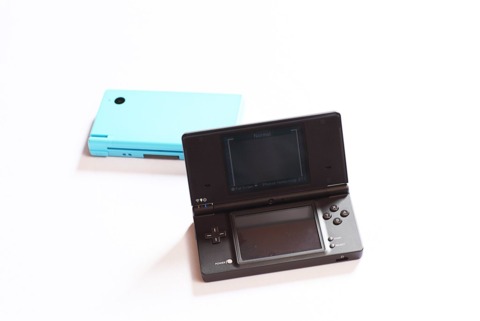GDC 2009: Nintendo drops DSi details
Project lead Masato Kuwahara discusses what gamers can expect from the forthcoming redesigned handheld, due out April 5.
The big news to come out of Nintendo president Satoru Iwata's 2009 Game Developers Conference keynote address this morning was the confirmation of a new Zelda game for the DS, The Legend of Zelda: Spirit Tracks. However, Nintendo also spent some time championing the DS's soon-to-be-released successor (though not replacement), the DSi. According to a representative, the redesigned handheld has sold 2 million units since its Japanese launch in November, with Amazon.com preorders in the US amounting to more than any game product in history.

Later in the day, Nintendo offered a more in-depth presentation on the DSi, which is expected to be released in the US on April 5. DSi project lead Masato Kuwahara hosted the session, which was titled "The Inspiration Behind Nintendo DSi Development." Kuwahara began his talk by giving a brief rundown of his previous experience at Nintendo, with highlights including work on the Game Boy Camera and Game Boy Printer, as well as the Game Boy Advance wireless adapter. This work, he said, heavily aided him in his role in leading development on the DSi.
According to Kuwahara, Nintendo saw that in 2006, there was about one DS per household in Japan. However, the company's goal was one DS per individual, and this became the driving force behind the DSi's development process. The question, he said, became, "What can we do to get each individual to purchase their own system and keep it near at all times?"
Kuwahara then went into some of the technical specifications of the DSi. As previously reported, the DSi's body was slimmed down by 2mm, and the weight was slightly reduced from that of the DS Lite. Nintendo also increased the device's screen size from 3 inches to 3.25 inches, which Kuwahara believes makes gameplay more enjoyable. He also said that the screens' backlight can now be adjusted in-game, and that a reset function has been added to the new power button.
The hardware designer then walked session attendees through the device's development process, saying that the first feature to be added was the two cameras. He said that the VGA cameras can be used with the DSi in a horizontal or vertical position. Kuwahara noted that Nintendo opted not to install traditional megapixel cameras, saying that this decision was partly due to cost concerns and partly because a greater resolution would reduce response time. He also said that a megapixel camera would have been too big to fit into its current position.
He then addressed the DSi's SD-card slots, saying that they would be compatible with both standard and SDHC cards. The SD slot, which he said was championed by preeminent Nintendo designer Shigeru Miyamoto, lets users store AAC music files, photos, and DSiWare purchases.
Sound quality was a major concern in redesigning the DS, Kuwahara said, and as such, the design team completely rebuilt the handheld's speakers. The DSi now has a louder speaker volume, and the analog volume switch has been swapped out for a digital control. The system can also be muted, he said.
Kuwahara said that, in one of Nintendo's "overturning the tea table" moments, the DSi was actually designed twice. The first iteration featured two game-cartridge slots, with the idea that players could switch between two different games on the fly.
Kuwahara then shifted his focus to DSi-compatible software. He first laid out the DSi Menu, which functions similarly to the Wii's Channel system. There are 39 slots in the Menu, and programs in these slots can be rearranged in any order. The Menu also lets device owners display a custom photo on the top screen.
Next, Kuwahara went into depth describing the DSi Camera program. Naturally, the software makes extensive use of the device's dual cameras, offering users 10 different lenses by which they can distort or reimage photos. Photos can be taken in standard mode, and then different lenses can be applied to the photo to add a variety of effects to the same picture.
The Distortion lens lets users warp photos using the stylus; Graffiti offers the ability to doodle on pictures; Color adds paint to otherwise black-and-white pictures; Color Pad adds the ability to alter the hue of objects in photos; Mirror reflects images in three different views; Mischief uses face-recognition software to add, for example, sunglasses or tears to pictures; Emote lets users tweak facial expressions; Merge morphs two faces into one; Resemblance analyzes the similarities between two faces; and Frame offers a variety of borders that photos can be inserted into.
Kuwahara then detailed DSi Sound, which acts as a music player and recording device. With the program, users can alter the playback speed and pitch of songs stored on an SD card. Songs can also be played backward, and 12 different sound filters can be applied.
The DSi Shop functions as a Wii Shop equivalent and is accessible through a Nintendo Wi-Fi Connect access point. Through the program, DSi users can purchase and download DSiWare software, with currency available for purchase directly through the shop by way of a credit card or by redeeming point cards bought at retail outlets. As announced earlier today, Nintendo will be giving away 1,000 points to everyone who logs into the DSi Shop with their handheld through October 5.
Lastly, Kuwahara also described the DSi Browser, which will be available as a free download through the DSi Shop. The browser offers a variety of display options, with either the entire page shown on the lower screen and a zoomed-in version appearing on the top, or a widescreen mode, in which a Web page is displayed to match screen size.
Got a news tip or want to contact us directly? Email news@gamespot.com
Join the conversation